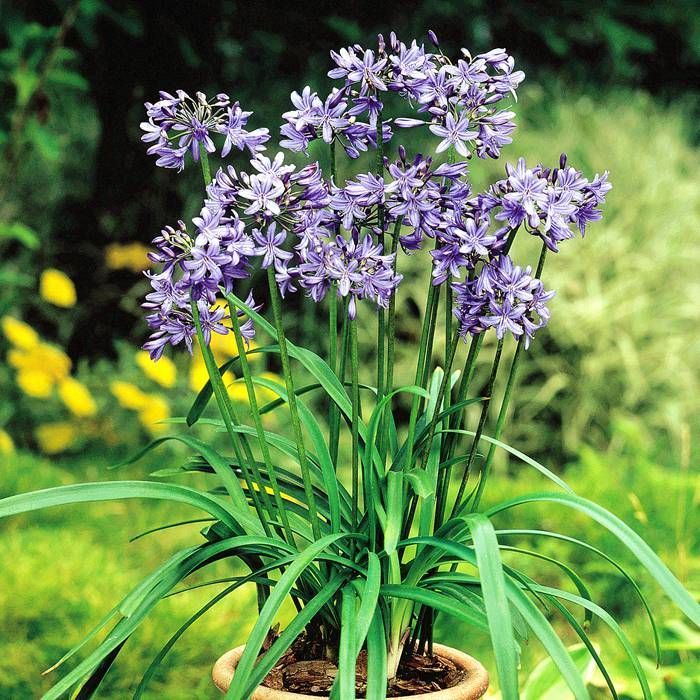Agapanthus Expanding Conditions: Dirt, Sunshine, and Watering
Wiki Article
Understanding the Art of Agapanthus Care: Crucial Steps for Healthy Growth and Vivid Blossoms
In the world of cultivation, the farming of agapanthus stands as a rewarding undertaking for those that look for to support these stylish blooming plants. From picking the appropriate selection to understanding pruning techniques, the trip towards growing prospering agapanthus plants is multifaceted and holds the vital to unlocking the full possibility of these organic treasures.
Picking the Right Agapanthus Range

When choosing the best Agapanthus range for your yard, take into consideration elements such as climate suitability, bloom color, and growth habit. Furthermore, think about the climate in your region to make sure the Agapanthus selection you pick can flourish in your certain conditions. Understanding the development behavior of various Agapanthus selections is important for correct positioning within your garden.
Ideal Growing Problems
Thinking about the optimal environmental requirements is necessary for effective Agapanthus farming. Agapanthus prospers in well-draining dirt with a slightly acidic to neutral pH level. When planting, select a place that obtains full sunshine to partial color. In hotter climates, offering some afternoon color can protect against scorching of the fallen leaves. Agapanthus plants are sensitive to cold temperature levels and should be protected from frost throughout winter months.To ensure healthy development and vibrant blooms, plant Agapanthus bulbs at a depth of concerning 2-4 inches and room them 8-12 inches apart. Mulching around the base of the plants aids maintain dampness and suppresses weed growth.
Watering and Feeding Tips
Maintaining correct dampness degrees and supplying important nutrients are crucial elements in the care routine for Agapanthus plants. It is vital to strike a balance when it comes to sprinkling Agapanthus. If overwatered, these plants prefer constantly moist dirt but are susceptible to root rot. During the growing season, water deeply as soon as a week, making sure the dirt is well-draining to avoid waterlogging. In hotter environments or during periods of drought, even more frequent watering might be needed to keep the soil evenly wet. Nevertheless, reduce watering in the winter season to protect against waterlogged conditions.Feeding Agapanthus is necessary for advertising healthy and balanced development and respected flowers. Use a well balanced plant food, such as a 10-10-10 formula, in the early spring as brand-new growth arises. Repeat this application every 6-8 weeks throughout the growing season. Prevent extreme fertilization, as it can result in lavish vegetation at the expense of blossoms. Constantly comply with the supplier's directions for correct dilution and application approaches. By adhering to these watering and feeding ideas, you can ensure your Agapanthus plants prosper and generate vivid, durable flowers.
Pruning Methods for Agapanthus
Trimming Agapanthus plants at the proper times and with proper methods is important for preserving their health and wellness and promoting optimum development and blooming. The ideal time to prune Agapanthus is in late wintertime or early springtime before new development arises.For flowered stems, wait till the blossoms have actually withered and afterwards trim them back to the base. This not only cleans up the plant's look yet likewise encourages the growth address of brand-new blossom buds. Deadheading spent blossoms can also redirect the plant's energy into generating more blooms as opposed to setting seeds. Nonetheless, if you desire to gather seeds for propagation, leave some blossoms to completely dry and mature on the plant.
Bear in mind to make use of clean, sharp tools to make specific cuts and decrease the danger of introducing illness. Agapanthus. Normal pruning will aid keep your Agapanthus looking healthy and cool while making sure a bountiful display screen of attractive blossoms
Managing Typical Bugs and Illness
After ensuring proper trimming strategies for Agapanthus, it is vital to attend to common pests and conditions that can affect the wellness and vigor of these plants. Agapanthus plants are normally durable but discover this info here can still succumb specific concerns. One common insect that influences Agapanthus is the Agapanthus gall midge. This small, orange fly lays its eggs in the vegetation, bring about distorted development and blossom buds that fall short to open. To combat this parasite, prune and damage any damaged plant parts and take into consideration utilizing insecticidal soap.Another usual concern is fungal fallen leave spot, which offers as dark lesions on the fallen leaves. To prevent fungal diseases, make certain good air blood circulation around the plants, stay clear of overhead watering, and get rid of any type of contaminated fallen leaves quickly. Furthermore, Agapanthus plants can click to find out more endure from root rot if they are grown in improperly draining pipes dirt. To stop this, plant Agapanthus in well-draining soil and avoid overwatering. By being attentive and taking prompt activity against pests and conditions, you can aid your Agapanthus plants prosper and create lively blossoms.
:max_bytes(150000):strip_icc()/agapanthus-growing-guide-7368912_06ba-bf1fa268243b451387986fbd1e2433b3.jpg)
Conclusion
To conclude, grasping the art of agapanthus treatment entails picking the ideal selection, supplying excellent growing problems, correct watering and feeding, appropriate pruning techniques, and resolving common parasites and conditions. By following these necessary steps, you can ensure healthy growth and dynamic blooms for your agapanthus plants. Remember to on a regular basis check and preserve your plants to promote their general well-being and longevity.To make certain healthy and balanced growth and dynamic flowers, plant Agapanthus light bulbs at a depth of regarding 2-4 inches and space them 8-12 inches apart. By complying with these watering and fertilizing tips, you can guarantee your Agapanthus plants thrive and produce vivid, resilient blossoms.
One typical parasite that influences Agapanthus is the Agapanthus gall midget. Additionally, Agapanthus plants can endure from root rot if they are planted in badly draining dirt. By following these essential steps, you can guarantee healthy and balanced growth and vibrant flowers for your agapanthus plants.
Report this wiki page